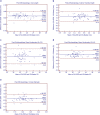Effect of orthokeratology on precision and agreement assessment of a new swept-source optical coherence tomography biometer
- PMID: 32161772
- PMCID: PMC7053116
- DOI: 10.1186/s40662-020-00177-4
Effect of orthokeratology on precision and agreement assessment of a new swept-source optical coherence tomography biometer
Abstract
Background: To evaluate the effect of orthokeratology on precision of measurements in children using a new swept-source optical coherence tomography (SS-OCT) optical biometer (OA-2000), and agreement between its measurements and those provided by the commonly used IOLMaster based on partial coherence interferometry (PCI).
Methods: This study recruited fifty-one eyes of 51 normal children (8-16 years). An operator took measurements with the two biometers. Then, a second operator took measurements with the SS-OCT biometer. After orthokeratology was performed for one month, the same operators repeated the same procedures. Axial length (AL), mean keratometry (Km) at 2.5 mm and 3.0 mm diameters (Km2.5 and Km3.0), central corneal thickness (CCT), anterior chamber depth (ACD), lens thickness (LT) and corneal diameter (CD) were analyzed.
Results: With the SS-OCT optical biometer, the test-retest repeatability of AL measurements was < 0.06 mm. For all parameters, the coefficients of variation were < 1.23% and the intraclass correlation coefficients were > 0.95. The 95% limits of agreement of difference between the two devices for CD parameter were up to 1.53 mm. After orthokeratology, the fluctuation ranges of difference for Km3.0 measurement was 1.11 times higher than before orthokeratology, while the absolute values of difference for AL, Km2.5, ACD and CD measurements were comparable.
Conclusions: Before and after orthokeratology, the SS-OCT biometer showed high repeatability and reproducibility for all measurements. Wearing orthokeratology contact lenses affected the agreement between SS-OCT and PCI biometers for Km3.0 measurements. The CD measurement showed poor agreement between the two devices.
Keywords: Agreement; Children; Orthokeratology; Precision; Swept source optical coherence tomography.
© The Author(s) 2020.
Conflict of interest statement
Competing interestsThe authors declare that they have no competing interests.
Figures


Similar articles
-
Repeatability and interobserver reproducibility of a new optical biometer based on swept-source optical coherence tomography and comparison with IOLMaster.Br J Ophthalmol. 2017 Apr;101(4):493-498. doi: 10.1136/bjophthalmol-2016-308352. Epub 2016 Aug 8. Br J Ophthalmol. 2017. PMID: 27503393
-
Agreement Between Two Optical Biometers Based on Large Coherence Length SS-OCT and Scheimpflug Imaging/Partial Coherence Interferometry.J Refract Surg. 2020 Jul 1;36(7):459-465. doi: 10.3928/1081597X-20200420-02. J Refract Surg. 2020. PMID: 32644168
-
Biometry measurements using a new large-coherence-length swept-source optical coherence tomographer.J Cataract Refract Surg. 2016 Jan;42(1):50-61. doi: 10.1016/j.jcrs.2015.07.042. J Cataract Refract Surg. 2016. PMID: 26948778
-
Repeatability and reproducibility of a new fully automatic measurement optical low coherence reflectometry biometer and agreement with swept-source optical coherence tomography-based biometer.Br J Ophthalmol. 2024 May 21;108(5):673-678. doi: 10.1136/bjo-2023-323268. Br J Ophthalmol. 2024. PMID: 37142332
-
Comparison of a New Optical Biometer That Combines Scheimpflug Imaging With Partial Coherence Interferometry With That of an Optical Biometer Based on Swept-Source Optical Coherence Tomography and Placido-Disk Topography.Front Med (Lausanne). 2022 Feb 10;8:814519. doi: 10.3389/fmed.2021.814519. eCollection 2021. Front Med (Lausanne). 2022. PMID: 35223885 Free PMC article.
Cited by
-
Reliability of a New Swept-Source Optical Coherence Tomography Biometer in Healthy Children, Adults, and Cataract Patients.J Ophthalmol. 2020 May 15;2020:8946364. doi: 10.1155/2020/8946364. eCollection 2020. J Ophthalmol. 2020. PMID: 32509343 Free PMC article.
-
Success Rate of Swept-Source Optical Coherence Tomography Biometry of Eyes of Elementary School Students.Clin Ophthalmol. 2022 Nov 1;16:3607-3612. doi: 10.2147/OPTH.S378286. eCollection 2022. Clin Ophthalmol. 2022. PMID: 36345531 Free PMC article.
-
Comparison of ocular biometry and refractive outcomes using two swept-source optical coherence tomography-based biometers.PLoS One. 2024 Dec 31;19(12):e0316439. doi: 10.1371/journal.pone.0316439. eCollection 2024. PLoS One. 2024. PMID: 39739867 Free PMC article.
References
-
- Santodomingo-Rubido J, Villa-Collar C, Gilmartin B, Gutiérrez-Ortega R. Myopia control with orthokeratology contact lenses in Spain: refractive and biometric changes. Invest Ophthalmol Vis Sci. 2012;53(8):5060–5. - PubMed
LinkOut - more resources
Full Text Sources
Miscellaneous

